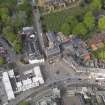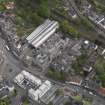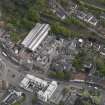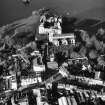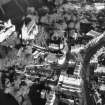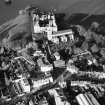Linlithgow, The Cross, Town House
Town House (17th Century)
Site Name Linlithgow, The Cross, Town House
Classification Town House (17th Century)
Alternative Name(s) Burgh Halls; Tolbooth; Townhall
Canmore ID 49180
Site Number NT07NW 13
NGR NT 00219 77204
Datum OSGB36 - NGR
Permalink http://canmore.org.uk/site/49180
- Council West Lothian
- Parish Linlithgow
- Former Region Lothian
- Former District West Lothian
- Former County West Lothian
Town House, 1668, John Smith
No other town in Scotland possesses such an imposing civic stage-set. Oliver Cromwell had demolished Linlithgow's old tolbooth with its gigantic campanile in 1650, in an attempt to improve the palace's defences. This splendidly alert successor, one of the most sophisticated burgh buildings of its period in Scotland, is three-storey, with regular pedimented windows, and the six-stage balustraded tower to the rear, which once carried a belfry as at Stirling Tolbooth (see Stirling and the Trossachs in this series). Second-floor room within boasts original massive fireplaces with carved overmantels and decorative swags. In 1810, the stone steps were replaced by a delicate iron loggia. After a fire in 1847, much rebuilt by Thomas Brown. The 1857 clock, by MacKenzie & Moncur, was the first turret clock in Scotland to be constructed on the same principles as that in Westminster Palace. In 1907, William Scott replaced the iron loggia with the magnificent double staircase. Designs for conversion to community arts use prepared by Malcolm Fraser Architects, 2007. The 1905 Masonic Halls, Market Lane, William Scott, has a handsome classical door beneath a masonic emblem.
Taken from "West Lothian: An Illustrated Architectural Guide", by Stuart Eydmann, Richard Jaques and Charles McKean, 2008. Published by the Rutland Press http://www.rias.org.uk
NT07NW 13.00 00219 77204
NT07NW 13.01 00213 77225 District Court (Old County Hall)
(NT 00209 77227) Town House (NAT) (1668)
OS 25" map (1856)
Linlithgow Town Hall was built in 1668-70, and, according to Waldie, entirely altered in 1807. After a fire in 1847, it was restored in 1848 with a Renaissance type facade. On plan, there is an original oblong block of three storeys, with a central tower, a slightly later addition, projecting from the N side. It replaced the Old Town House, demolished by Cromwell in 1650, and is now being extensively renovated (SDD List 1963).
RCAHMS 1929, visited 1927; G Waldie 1894
This building is generally as described. There are several blocked-up doors and windows in the N and W walls. One of these windows has a stone bearing the following inscription: "Doorway to debtors' prison struck out in 1792, built up 1812".
Visited by ODS (BS) 21 March 1974
NMRS REFERENCE:
ARCHITECT: See under John Mylne in architect's file (1668-70)
Plans:
Dick Peddie & MacKay, Edinburgh fore-stair
Bin 16, Bag 1 WH Scott 1905
Publication Account (1981)
It is impossible to say when the first Tolbooth was built in the burgh. The ‘Pretorium Antiquum Burgi’ was one of the patrimonies of the altar of the Blessed Virgin Mary in the parish church and the earliest extant document relating to the altar. is dated 1374 (GD 215/1822). The Tolbooth served as part of Cromwell's defences in the 1650s and after the Restoration compensation was granted to the burgh to build a new one. It was rebuilt in 1668-70 and was a three-storeyed structure with a stair tower and spire added later. A pitched slate roof replaced a flat one in 1790 and the Tolbooth suffered fire damage in 1845. The staircase that aderns the front of the building was not added until 1907 (MacDonald, 1932, 58). Sibbald, writing in 1710, observed that the Tolbooth was a ‘stately fabric' with the sheriffs and magistrates both keeping their courts in this building {1710, 15). The structure on the ground floor had accommodation for prisoners and a weighhouse while the top storey served 'for public feasts and entertainments (Sibbald, 1710, 15).
Information from ‘Historic Linlithgow: The Archaeological Implications of Development’ (1981).
Publication Account (1996)
This is a three-storeyed rectangular block measuring 19.1m by 9.3m and having a square six-storeyed stair-tower at the centre of the rear (N) elevation. Its seven-bay S front was refaced with ashlar, and the upper part rebuilt, after a severe fire in 1847. The ground floor is entered by a central doorway enclosed by a double flight ofbalustraded steps, constructed in 1905, which rise to a principal entrance at first-floor level and mask the lower part of the elevation.
Throughout the building the windows of the upper floors are surmounted by triangular pediments containing thistles and other symbols of the Union. A slightly larger pediment over the first-floor doorway, which shows the 'black bitch and tree', the emblem of Linlithgow, was installed during the repairs of 1848 to replace an armorial panel above a somewhat lower doorway. The cornice and blocking-course, both renewed in 1848, enclose hipped roof of the same date, whose predecessor was built in 1790 to replace an original flat leaded roof with balustrade. This was reached from the stair-tower through a surviving doorway above which there is a roll moulded frame for an armorial panel.
The two-bay W wall facing Kirkgate is built of weathered yellow ashlar, which was not renewed in 1848, whereas the N and E walls are of rubble, also much weathered, and most of their sculptured window-pediments appear to be unrestored. The two moulded string-courses, cornice and truncated chimney stacks were renewed in 1848 using a darker stone.
The tower is built of similar rubble, and its six stages are defined by string-courses. In the second stage of its W face there is a blocked doorway with a lintel inscribed 'Doorway to debtor's prison struck out in 1792 built up in 1812'. The two upper stages of the tower contain narrow round-arched windows, and clock-faces to E,S and W. Its balustrade was rebuilt in 1848, and originally enclosed a lead-covered timber spire.
In the original arrangement, the central area of the ground floor was used as a weigh-house and also contained, to the W, a timber-built girnel. This was separated by a masonry wall from the 'wester tolbooth', which occupied the Wend and was entered by an external door in the S wall, as was the corresponding but smaller 'easter tolbooth'. In the NE angle behind the latter prison there was a 'black hole ', entered from the weigh-house as was a vaulted 'dark prison' in the base of the stair-tower. In 1827 the E wall of the W prison was moved some distance to the E, and two parallel E-W vaulted cells were formed. Until 1845 the ground floor was independent of those above, but following the removal of the prison to a new building it became one of the main entrances to the court-room and County Buildings. The former 'black hole' in the NE corner became a lobby, with a doorway in the N wall opening into a new staircase which communicated with the court-room above and with the County Buildings. This door was blocked in 1962-3, and the vaulted cell in the tower was replaced by a new stair, while the dividing-wall between the two W vaults was removed, and the two E rooms were combined for the first time.
The first floor was entered from the forestair through a central lobby at whose N end there was a newel-stair in the tower. In the 18th century the council-chamber was to the W, where its original fireplace survives, and the court-room was to the E. These positions were reversed in 1962-3, and the new court-room was enlarged to include the former lobby. The entrance to the tower is through a lugged stone doorcase which appears contemporary with the building and may be the original first-floor doorway, replaced in 1848 (supra) . The whole of the second floor is occupied by the town hall, a magnificent chamber which was formed in 184810 but retains in the end-walls two original stone chimneypieces complete with overmantels. Their friezes are decorated with thistles, roses and fleurs-de-lis, reflecting the symbolic programme in the external pediments.
HISTORY
'The ancient council-chamber of the burgh' was one of the endowments of the altar of St Mary in St Michael's Church, founded before 1374. It is not known when the tolbooth was built on the present site, but it is mentioned in a charter of 1507-8. This building was 'razed to the ground be the Inglish at thair incoming to this kingdome in anno 1650', and the stones and timber were 'applied towardis the workis and fortifications about the Castle of Lythgow,'
In 1661 the town council set about raising funds to rebuild the tolbooth and a royal grant of a levy on malt and ale, obtained in 1666, was supplemented by voluntary subscriptions. In November 1667 John Mylne, the King's Master Mason, prepared a design for the new building for which he received immediate payment of £88 12s Scots. He died in the following month, and in January 1668 the Council approved 'the concording with John Smith maister measson for edifieing our tolbuith in all respects conforme to the draught thereof drawn up be him'. A contract was made in the same year for the supply of stone from Kingscavil quarry, and the inhabitants were called on to transport stone and other building-materials. Smith completed the mason work in 1670, although work on the roof and steeple, using Dutch lead, continued until 1673.
A series of drawings for the tolbooth, now lost but published in 1893, includes three different schemes. The first, whose ground-plan bears the initials of John Mylne and the date 7 November 1667, shows a three-storeyed L-plan building with vaulted rooms, presumably cells, in the NE wing. The seven-bay main front, 23m in length, has a central entrance-tower rising above a high roof with pedimented dormers, and there is a faceted stair-tower at the rear. Elements of this plan reappear in a set of floor-plans, presumably by John Smith, for a seven-bay rectangle, 28m long, having a central door below a double forestair, and a square stair-tower at the centre rear. A single ground-plan shows a less elongated version of the same plan, and corresponds closely to the town-house as built.
In 1710 certain windows on the ground floor were blocked to improve the security of the jail. In 1722 the steeple and 'bartesan' were repaired and in 1752 it was proposed to install sash-and-case windows and to refurnish the court-house. The court-room was repaired in 1786 at the expense of the county, for use by the SheriffCourt. The major alteration during this century was the replacement in 1790 of the balustraded flat roof with a hipped one of 'skailie' (blue slate) by lames Buncle, deacon of the wrights.
The original forestairs to the first floor were described in 1810 as 'much decayed', and Richard Crichton was employed to erect a cast-iron verandah in Regency taste, which may have been the work of the Carron Iron Company. This provided market-space and carried a first-floor balcony, but removed the access to the former principal entrance. It is possible that a substitute stair to the court-room was built against the E part of the N wall, but the erection of the County Rooms to the N of the town-house in 1819-21 provided access via a spacious hall and staircase to both buildings. Improvements made to the jail in 1827 by Thomas Brown, an Uphall builder-architect, included the creation of two vaulted cells, one of them for debtors. Following the building of a new jail in 1845, the ground floor was transferred by the prison board to the county authorities, who opened a doorway from the NE ground-floor room to the main staircase.
The fire of 1847 caused extensive damage to the upper floors of the building, and the whole roof was lost, as well as the spire. Following a dispute between the burgh and the county authorities over their respective rights in the building, it was agreed that it should be restored to its pre-fire state. William Nixon was appointed to report on the damage but withdrew due to ill health, and was replaced by another Edinburgh architect, Thomas Brown. The work was completed during 1848, at its estimated cost of about £800. The exterior required extensive repair, including new roofs for the main block and tower, but the most expensive element was the treatment of the S front, which was refaced and partly rebuilt 'in the same style and exactly in the form of the present building. The facade was completed with an inscribed frieze below the cornice, commemorating the fire and rebuilding. The iron verandah at the ground level was retained. The only major internal work undertaken was the formation of the large top-floor hall, and the alterations to its floor and roof described above.
A bell by John C Wilson and a clock by Mr Mackenzie, both of Glasgow, were installed through public subscription in 1857. During the late 19th century a fire-station was created in the SW vault of the ground storey, where the lintel of double doors opening into Kirkgate is still visible. Alterations proposed in 1886 by J Russell Walker were not executed, but in 1905 the cast-iron verandah was replaced by a double flight of return stairs, restoring the principal door to its original importance.
The most extensive alterations made to the building since its erection were carried out by Rowand Anderson, Kininmonth and Paul in 1962-3, to create a suite of burgh halls. On the ground floor the wall dividing the two vaulted rooms to the W was removed, and the two rooms E ofthe entrance-hall were also combined. The vault of the cell in the base of the tower was destroyed and a staircase inserted to the first floor. On the first floor the W room became the court-room and was extended to incorporate the original entrance-hall, and the newel-stair in the tower was replaced by a concrete scale-and platt stair.
Information from ‘Tolbooths and Town-Houses: Civic Architecture in Scotland to 1833’ (1996).
Publication Account (2000)
Linlithgow's townhouse figure 17, fronting onto the market place at the foot of Kirkgate, was constructed in 1668- 70 by John Smith, to a design of John Milne, master mason to Kings Charles I and II. It stands on the site of the old tolbooth, demolished on the instructions of Oliver Cromwell. With a double staircase giving access to the first floor and a spire added in about 1673, its original form may be seen prominently on Slezer's engravings of Linlithgow in Theatrum Scotiae figure 16. This new tolbooth reduced the width of Kirkgate by approximately eight feet (2.4 metres). The interior was embellished with paintings by a Dutchman, who was paid £6 7s 7d for his efforts, and in 1670/71 two clocks were made, one for the tolbooth steeple and the other for the church steeple.
In 1790, it was agreed that a corn and victual market was to be erected at the back of the council chambers; the third storey functioned as a debtors' prison. Other alterations were soon made. In 1810, the town council took the decision to replace the stairs at the front of the townhouse with a verandah, or piazza. Fire broke out in 184 7, however, destroying much of the fabric, even though the town's 'water engine', or fire engine, was housed immediately adjacently, beside the county hall at the rear of the townhouse. According to the town council minutes, the fire was suspected to have been caused by the concentrated rays of the sun through a window leading to 'spontaneous combustion'. The following year, rebuilding was under way, but instead of following the Milne design of 1668, the facade was still furnished with a wrought iron piazza and the tapering spire was not replaced. The townhouse retains most of these nineteenth-century features, although the wrought iron piazza was replaced in 1907 with the existing double stairway; and the County Hall was added to the rear.
Information from ‘Historic Linlithgow: The Archaeological Implications of Development’ (2000).
Standing Building Recording (23 July 2007)
NT 0021 7721 A programme of archaeological works was undertaken on 23 July 2007 at the Burgh Halls. This comprised historic building recording inside the building and monitoring engineering test pits and trial trench evaluation in the garden area to the rear. The work was in advance of proposed refurbishment of the Burgh Halls and construction of a rear extension. The building recording was undertaken at the request of the client.
The evaluation lay within a scheduled ancient monument (SAM No. 90201) and required scheduled monument consent.
Archive to be deposited with RCAHMS and report deposited with WoSAS SMR.
Funded by: West Lothian Council.
Trial Trench (23 July 2007)
Trial trenching of around 20% of the area revealed the extent of modern disturbance from the 1980s works and exposed walls possibly relating to the corner of a building surviving beneath this disturbance. The walls appear to predate Wood’s map of the area from the 1820s. The earliest artefact from the site was redeposited and 17th–18th-century in date; no dateable archaeological finds were associated with the early walls. The walls may relate to one of the structures in the vicinity of the Kirkgate demolished by Cromwell around 1650, or to his
refortifications.
Archive to be deposited with RCAHMS and report deposited with WoSAS SMR
Funded by: West Lothian Council.
Watching Brief (12 December 2008 - 4 November 2009)
NT 0021 7721 A watching brief was undertaken 12 December 2008–4 November 2009 during works related the refurbishment of the Burgh Halls and the construction of a new extension. The area of the extension, to the rear of the Burgh Halls, was considered sensitive as it is located within a scheduled ancient monument (SAM 90201). The Burgh Halls and the garden to the rear lie to the S of the graveyard of St Michael's parish church. A reference in the Linlithgow Burgh Survey (AD 1187) suggests that a school was accessed from the E side of the Kirkgate and was probably located close to the church. An almshouse, dating from before 1448 and surviving until the 17th century was also located on the E side of the Kirkgate to the S of the cemetery.
The groundworks exposed a number of deposits and features of archaeological significance. A 15th-century jeton was recovered from soil deposits containing wall foundations within the footprint of the Burgh Halls. In the garden to the rear of the Burgh Halls the remains of two basement rooms were recorded. One of the rooms had been backfilled with a deposit containing 15th-century pottery. Another wall foundation which predated the 16th 17th centuries was located to the front of the Burgh Halls. It is considered that these structural remains may relate to either the school or the almshouse.
Archive: RCAHMS (intended). Report: WoSAS
Funder: West Lothian Council
Headland Archaeology Ltd, 2009

































